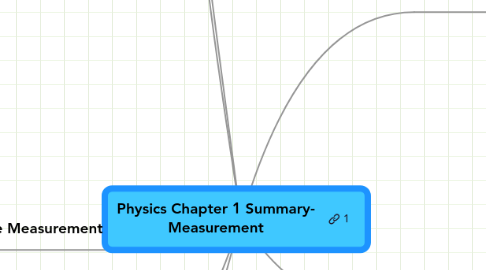
1. SI units- International system of units
1.1. Includes Length, Mass, Time, etc.
1.1.1. Important Units
1.1.1.1. Base Quantities/Name/Symbol
1.1.1.1.1. Length/Meter/m
1.1.1.1.2. Mass/Kilogram/kg
1.1.1.1.3. Time/Second/s
1.1.1.1.4. Electric Current/Ampere/A
1.1.1.2. Derived Quantities/Equation/Symbol/Special name (if any)
1.1.1.2.1. Area/l x w/m (2)
1.1.1.2.2. Volume/l x w x h/m (3)
1.1.1.2.3. Force/m x A/.../Newton (N)
2. Measurement of Length
2.1. Accurate measurement
2.1.1. No measurement is perfectly accurate
2.1.2. Three types of Errors
2.1.2.1. Random
2.1.2.1.1. They are inconstant errors, e.g., time of one oscillation
2.1.2.2. Systematic
2.1.2.2.1. A consistant error in measuring, e.g., measuring without adding/deducting the zero error.
2.1.2.3. Parallex
2.1.2.3.1. The eye is not aligned with the measuring tool OR the object is not aligned with the scale
2.1.3. Read the measurement (length) when...
2.1.3.1. Your eyes are perpendicular to the scale
2.1.3.2. The object is aligned properly with the ruler
2.2. Types of Measurement tools (Please note that I own none of the videos)
2.2.1. Ruler
2.2.1.1. For short lengths (≥30)
2.2.2. Meter Rule
2.2.2.1. For lengths ≥1m
2.2.3. Measuring tape
2.2.3.1. For longer length (depends, usually ≥3m)
2.2.4. Vernier Caliper
2.2.4.1. For an accuracy of 0.01cm
2.2.4.2. Parts
2.2.4.2.1. Inner Jaws
2.2.4.2.2. Outer Jaws
2.2.4.2.3. Main Scale
2.2.4.2.4. Vernier Scale
2.2.4.2.5. Depth Probe
2.2.4.2.6. http://www.youtube.com/watch?v=hraBV0eFPZU&feature=related
2.2.4.3. How to use it
2.2.4.3.1. http://www.youtube.com/watch?v=kTLhmptHAPc&feature=related
2.2.5. Micrometer Screw Gauge
2.2.5.1. For an accuracy of 0.01mm
2.2.5.2. Parts
2.2.5.2.1. Anvil
2.2.5.2.2. Spindle
2.2.5.2.3. Sleeve
2.2.5.2.4. Thimble
2.2.5.2.5. Ratchet
2.2.5.3. How to use it
2.2.5.3.1. http://www.youtube.com/watch?v=O8vMFFYNIfo&feature=related
3. Measurement of Time
3.1. Accurate Measurement
3.1.1. Don't measure races to the point of 0.01s, because the reaction time might lag
3.2. Types of Measurement Tools
3.2.1. Watch
3.2.1.1. For long intervals of time
3.2.1.2. Most depend on quartz crystals for accurate timing
3.2.1.3. Battery
3.2.1.3.1. Quartz
3.2.1.3.2. Coiled Spring
3.2.2. Digital Stopwatch
3.2.2.1. Up to an accuracy of 0.01 seconds
3.2.3. Analogue Stopwatch
3.2.3.1. Up to an accuracy of 0.1 seconds
3.2.4. Pendulum Clock
3.2.4.1. For long intervals of time
3.2.4.2. The pendulum swings and the gravitational potential energy is converted into elastic potential energy.
3.2.4.3. An oscillation is when a pendulum swings from one point and back
3.2.4.3.1. The time for a complete oscillation is called one period
4. Measurement of Area, Volume and Mass
4.1. Area
4.1.1. Regular
4.1.1.1. m^2 and cm^2 are normally used
4.1.1.2. To calculate this, use a formula, depending on the shape
4.1.2. Irregular
4.1.2.1. Place the object on a square grid and trace it. Count the number of more than half filled squares to be the area
4.1.2.2. To be more accurate, use a smaller grid
4.2. Volume
4.2.1. Regular
4.2.1.1. m^3 and cm^3 are normally used
4.2.1.2. To calculate this, use a formula, depending on the solid
4.2.2. Irregular
4.2.2.1. Fill a measuring cylinder to a certain amount of water and lower the solid in. The increase of the water level is the volume
4.3. Mass
4.3.1. kg and g are normally used
4.3.2. Measurement Tools
4.3.2.1. Beam Balance
4.3.2.2. Electronic Balance
5. Temperature Measurement
5.1. ºC is normally used
5.2. Thermometers
5.2.1. Alcohol
5.2.1.1. It is coloured to increase visibility
5.2.1.2. Range: -70ºC to 78ºC
5.2.2. Mercury
5.2.2.1. It is poisonous
5.2.2.2. Range: -38.83ºC to 356ºC
5.2.3. Made of glass
6. Physical Quantities
6.1. Base quantity
6.2. Derived quantity
6.2.1. A product of base quanitities
6.2.2. E.g.,
6.2.2.1. area= length x width
6.2.2.2. volume= length x width x height
6.2.2.3. force= mass x accelaration
6.3. Consists of a magnitude and unit
7. Prefixes
7.1. Prefix/Abbreviation/Power
7.1.1. nano/n/10^-9
7.1.2. mirco/µ/10^6
7.1.3. milli/m/10^-3
7.1.4. centi/c/10^-2
7.1.5. deci/d/10^-1
7.1.6. kilo/k/10^3
7.1.7. mega/M/10^6
7.1.8. giga/G/10^9
7.1.9. tera/T/10^12
7.2. To simplify huge or minuscule quantities, an alternative
7.3. They increase/decrease by thousands, most of the time
7.3.1. E.g., From kilo(10^3) to mega(10^6)
